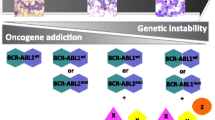Abstract
Many of the therapeutic agents used for cancer chemotherapy today are based on decades-old agents which are highly cytotoxic but are nonselective for cancer cells. The hallmark of chronic myelogenous leukemia (CML) is the Philadelphia chromosome translocation t(9;22), which results in the bcr-abl fusion gene. As an alteration that is nearly universal in CML cells, bcr-abl presents a therapeutic target that is unique to the pathological cells in CML patients. Advances in the understanding of the molecular mechanisms which sustain leukemic cells in CML have enabled the development of selective therapies for this disease. We review here the molecular pathogenesis and current treatment of CML. We also discuss the development of imatinib mesylate, a selective inhibitor of Bcr-Abl which has shown promise in clinical trials with CML. This recent advance in CML therapy represents a novel approach to rational design and development of new anticancer drugs.
Similar content being viewed by others
Author information
Authors and Affiliations
Additional information
Electronic Publication
Rights and permissions
About this article
Cite this article
Sharifi, N., Steinman, R.A. Targeted chemotherapy: chronic myelogenous leukemia as a model. J Mol Med 80, 219–232 (2002). https://doi.org/10.1007/s00109-001-0305-3
Received:
Accepted:
Published:
Issue Date:
DOI: https://doi.org/10.1007/s00109-001-0305-3




